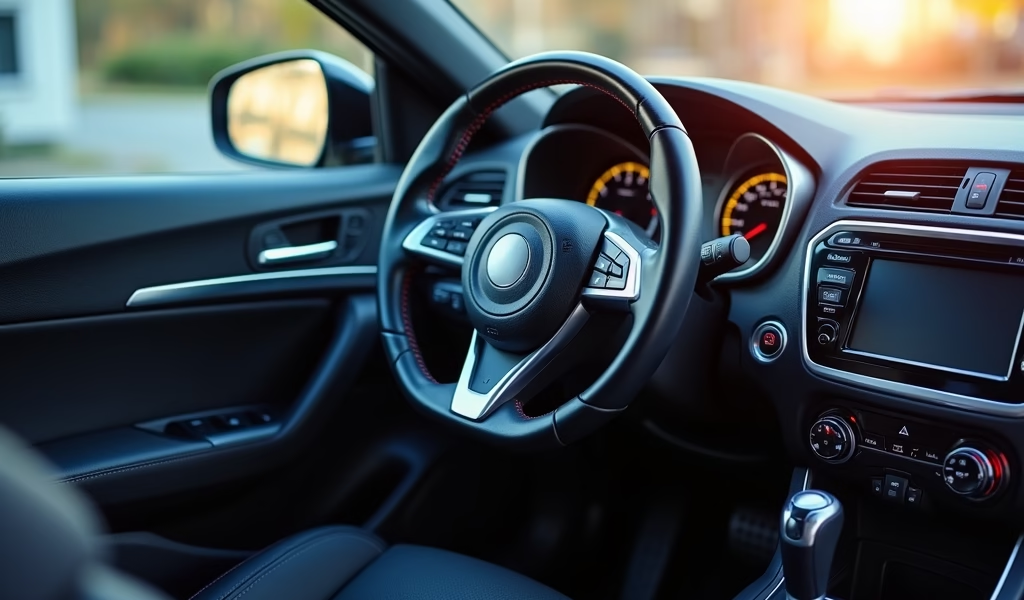Overview
This article provides five practical solutions for steering wheel position sensor issues, including resetting, cleaning connections, recalibration, replacement, and checking related systems, while explaining how this critical component impacts vehicle safety features like stability control and power steering. Warning signs of sensor failure include dashboard warning lights, inconsistent steering feel, and off-center steering wheel alignment, with proper maintenance being essential for preventing future problems.
Table of Contents
- Understanding Steering Wheel Position Sensor
- Warning Signs of a Failing Sensor
- Fix #1: Reset the Sensor
- Fix #2: Clean the Connections
- Fix #3: Recalibrate the Sensor
- Fix #4: Replace the Sensor
- Fix #5: Check Related Systems
- Preventing Future Sensor Problems
- Conclusion
- Frequently Asked Questions
Understanding Steering Wheel Position Sensor
That strange feeling when your car doesn’t steer quite right? It might be your steering wheel position sensor acting up. I’ve seen countless drivers frustrated by this small but mighty component that lurks just behind your steering wheel.
Think of this sensor as your vehicle’s directional compass. It constantly monitors the angle and rotation of your steering wheel, sending vital information to your car’s computer systems. This data helps coordinate everything from your power steering assistance to critical safety systems.
Modern vehicles rely on this humble sensor for coordinating several essential systems:
- Electronic Stability Control (ESC)
- Anti-lock Braking System (ABS)
- Power steering assistance
- Lane-keeping assistance
- Advanced driver-assistance systems
When working properly, you’ll never notice it. But when things go south, your car’s handling can become unpredictable, safety systems may disable themselves, and warning lights start decorating your dashboard.
As a mechanic with 15 years under my belt, I’ve fixed hundreds of these sensors. The good news? Many issues can be resolved without breaking the bank. Let’s dive into how to spot the problem and the five most effective fixes I’ve discovered.
Warning Signs of a Failing Sensor

Your car might not speak English, but it has plenty of ways to tell you when the steering wheel position sensor is on the fritz. Here are the symptoms I see most often in my shop:
The most obvious sign is illuminated warning lights. Your dashboard might suddenly light up with ABS, ESC, or power steering warnings. Think of these as your car’s way of waving red flags.
Notice your steering feeling inconsistent? Sometimes too light, sometimes too heavy? That’s another telltale sign. The sensor might be sending erratic signals to your power steering system, making it behave like it’s had too much coffee.
One of the more dangerous symptoms is when your stability control system activates at inappropriate times – or worse, doesn’t activate when needed. I had a customer whose car unexpectedly applied brakes during highway driving because the sensor was sending false signals.
If your steering wheel sits off-center when driving straight, that’s your car literally pointing to the problem. The sensor may be misaligned or miscalibrated.
Unusual clicking, grinding, or whirring noises during steering maneuvers can also indicate sensor problems, though these could point to mechanical issues too.
According to NHTSA research, properly functioning stability control systems reduce single-vehicle crashes by up to 35%. This makes addressing steering sensor issues not just a convenience but a safety priority.
Fix #1: Reset the Sensor
Sometimes the simplest fix works best. Just like you might restart your phone when it acts up, resetting your steering wheel position sensor can clear electronic gremlins without replacing parts.
I recommend this as your first attempt, especially if the problem appeared suddenly. Here’s my tried-and-true reset method:
- Park on a level surface and turn off the engine
- Disconnect the negative battery terminal (the black one)
- Wait 15-20 minutes (this allows the car’s computer systems to fully reset)
- Reconnect the battery terminal (make sure it’s tight!)
- Start the engine and drive straight on level ground for 5-10 minutes
This reset allows the vehicle’s computer to “forget” any stored error conditions and relearn the center position of your steering wheel. It’s particularly effective for temporary electronic glitches or after you’ve had work done on your steering system.
The beauty of this approach? It costs nothing but 20 minutes of your time, while a shop might charge you $50-100 for essentially the same procedure. I’ve seen this fix work on everything from economy cars to luxury vehicles.
However, if your sensor has physical damage or severe electrical problems, a reset will only temporarily mask the symptoms. In that case, you’ll need to move on to the next fixes.
Fix #2: Clean the Connections
In my years turning wrenches, I’ve learned that dirt and corrosion are the silent killers of electrical components. Your steering wheel position sensor is no exception.
Poor electrical connections can cause intermittent sensor failures that drive you (and your mechanic) crazy. One minute everything works fine; the next, warning lights flash like a disco.
Here’s my professional approach to cleaning those connections:
- Locate the sensor (typically near the steering column under the dashboard)
- Disconnect the battery for safety (electrical shocks aren’t fun, trust me)
- Carefully unplug the electrical connector from the sensor
- Inspect for green/white corrosion, dirt, or moisture
- Clean the contacts with electrical contact cleaner and a soft brush
- Let it dry completely (patience pays off here)
- Apply a tiny amount of dielectric grease to prevent future corrosion
- Reconnect everything firmly
This fix costs about $15 in supplies and takes 30-45 minutes, depending on how buried your sensor is. The trickiest part is often accessing the sensor, which might require removing panels or steering column covers.
I recently fixed a Mercedes that had been to three different shops with an intermittent steering sensor issue. The problem? Just a bit of coffee that had spilled into the connector months earlier, causing corrosion. A thorough cleaning saved the owner hundreds in unnecessary parts.
If cleaning doesn’t solve your issue, or if the connections look pristine already, it’s time to consider recalibration.
Fix #3: Recalibrate the Sensor
Even a perfectly functioning sensor needs to know where “straight ahead” actually is. Recalibration teaches your car to find its true north, so to speak.
Think of it like setting the time on your watch – the watch works fine, but if it’s showing the wrong time, it’s not very useful. Similarly, your steering sensor needs proper calibration to accurately report steering wheel position.
Recalibration becomes necessary after:
- Wheel alignment service
- Steering component replacement
- Battery disconnection (in some vehicles)
- After resetting or cleaning the sensor
Some vehicles allow for a DIY recalibration process. This typically involves:
- Starting on level ground
- Turning the steering wheel lock-to-lock (all the way left, then all the way right)
- Centering the wheel
- Driving straight for several minutes
However, modern vehicles with advanced driver assistance systems often require professional calibration using specialized diagnostic equipment. The traction control system calibration is particularly sensitive to steering angle data.
Professional recalibration costs between $50-150 at an independent shop, or up to $200 at dealerships. While not cheap, proper calibration prevents more expensive problems down the road.
I’ve seen improper calibration cause stability control to activate during normal driving or fail to activate during emergency maneuvers – neither situation is one you want to experience firsthand.
Fix #4: Replace the Sensor

Sometimes, a sensor is just beyond saving. If you’ve tried resetting, cleaning, and recalibrating without success, replacement becomes the logical next step.
How do you know it’s time for replacement? Look for these indicators:
- Persistent warning lights after attempting other fixes
- Diagnostic scan tools showing consistent sensor errors
- Physical damage to the sensor (often visible upon inspection)
- Erratic steering assistance regardless of other repairs
Replacement sensors typically cost between $100-300 for the part alone, depending on your vehicle make and model. High-end luxury cars can run even higher. Labor adds another $100-200 to the bill.
If you’re handy with tools and comfortable working on your car’s electrical systems, this can be a DIY job. Here’s the basic process:
- Purchase the correct sensor for your specific vehicle
- Disconnect the battery (always safety first!)
- Remove necessary panels to access the sensor
- Note the position of the steering wheel (straight ahead is ideal)
- Disconnect and remove the old sensor
- Install the new sensor in exactly the same position
- Reconnect wiring and reinstall panels
- Perform necessary calibration procedures
A word of caution: on vehicles equipped with airbags (which is virtually all modern cars), working near the steering column requires extreme care. If you’re not confident, this is one repair best left to professionals. I’ve seen too many DIY disasters involving accidentally deployed airbags.
After replacement, professional calibration is almost always necessary. According to research by the Society of Automotive Engineers, proper calibration ensures your vehicle’s safety systems function correctly in emergency situations.
Fix #5: Check Related Systems
Sometimes what seems like a steering wheel position sensor problem is actually caused by something else entirely. Like a good detective, a thorough mechanic looks beyond the obvious suspect.
In my experience, these related components often masquerade as sensor issues:
The clock spring (spiral cable) sits between your steering wheel and column, connecting steering wheel controls to the rest of the car. When damaged, it causes symptoms identical to sensor failure. Check for airbag warnings, non-working horn, or cruise control issues alongside steering problems.
Steering column wear or damage can affect sensor readings. Excessive play in the column, unusual noises, or visible damage are telltale signs of mechanical issues affecting your sensor readings.
Electronic control modules might be the real culprits. Sometimes the sensor works perfectly, but the module receiving its signals is failing. A comprehensive diagnostic scan can identify module communication errors.
Power steering systems, particularly in vehicles with electric power steering, can cause symptoms that mimic sensor failure. Strange steering feel, inconsistent assistance, and warning lights can stem from power steering issues rather than sensor problems.
The active suspension sensor calibration systems in luxury vehicles often share data with steering sensors, creating complex diagnostic challenges when things go wrong.
A thorough diagnosis by a qualified technician might cost $100-200, but it prevents replacing parts unnecessarily. I’ve saved customers thousands by identifying the actual problem rather than following the most obvious diagnosis.
Preventing Future Sensor Problems
An ounce of prevention is worth a pound of cure – especially when it comes to sophisticated electronic components like steering sensors.
After fixing hundreds of these issues, I’ve developed some practical advice to keep your steering sensor healthy for the long haul:
- Protect your steering wheel from impacts. Avoid slamming into potholes or curbs that can jolt the steering system.
- Keep the interior dry. Water damage is a common killer of electronic components. Fix leaking windshields or sunroofs promptly.
- Address warning lights quickly. Early intervention often prevents cascading failures in interconnected systems.
- Maintain proper wheel alignment. Misaligned wheels create stress on steering components, including sensors.
- Use quality parts for repairs. Aftermarket sensors vary wildly in quality – sometimes OEM parts are worth the extra cost.
Regular maintenance checks should include a brief inspection of steering components. A good mechanic will spot potential issues before they become major problems.
If you’ve recently had a collision repair, even a minor one, consider having your steering sensor calibration verified. Body shops don’t always include this step, but it’s crucial for proper system operation.
Remember that modern vehicles are incredibly complex, interconnected systems. That $100 sensor is connected to safety equipment worth thousands – making proper maintenance not just a financial decision but a safety priority.
Conclusion
Your steering wheel position sensor might be small, but its impact on your vehicle’s safety and handling is enormous. From enabling your stability control systems to ensuring your power steering works correctly, this humble component deserves serious attention when things go wrong.
Through my years in the garage, I’ve found that starting with simple fixes often works wonders. A reset or cleaning can resolve many issues without the expense of replacement parts. When those don’t work, proper diagnosis, recalibration, or replacement by qualified professionals ensures your vehicle handles safely for years to come.
Remember that this sensor doesn’t exist in isolation – it’s part of an intricate network of safety and control systems in your modern vehicle. Proper repair ensures everything from your ABS to your lane-keeping assistance functions as designed.
The next time your steering feels off or those warning lights appear, you’ll know where to start looking. With the right approach, you can save money while keeping your vehicle safe and responsive on the road.
Frequently Asked Questions
How much does it cost to replace a steering wheel position sensor?
Replacement typically costs between $200-500 total. The part usually runs $100-300, with labor adding another $100-200 depending on vehicle complexity.
Can I drive with a bad steering wheel position sensor?
It’s not recommended as it may disable crucial safety systems like stability control and ABS. Your vehicle might be drivable but significantly less safe in emergency situations.
Will disconnecting the battery reset the steering angle sensor?
Yes, disconnecting the battery for 15-20 minutes will often reset the sensor’s stored values. However, recalibration may still be needed afterward for proper operation.
How do I know if my steering angle sensor is bad or just needs calibration?
Persistent warning lights and steering issues after reset attempts usually indicate a bad sensor. Professional diagnostic equipment can confirm whether calibration or replacement is needed.
Do I need special tools to calibrate a steering wheel position sensor?
Most modern vehicles require specialized diagnostic equipment for proper calibration. While some basic relearning procedures can be done without tools, full calibration typically requires professional equipment.

